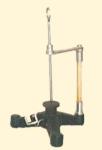 Menu
Menu
|
Function To show the thickening of the charges on the points. |

| ||
|
|||
|
Description To the same insulating support we can apply an accessory with a steel needle to hold a fly with five o six sharpened radius, or a brass pole at right angle that ends with a tip for the electric puff. A lateral hook allows connecting the apparatus to one of the conductors of the electrostatic machine that, in this case, must be used without capacitors. | |||
|
Function To show the capability of an electric spark to pierce a glass sheet. |

| ||
|
|||
|
Description A metallic plate is fixed to a tripod. From the above end of a column of insulating material, fixed on one of its feet, comes a bar that ends with a ring. In the ring a metallic needle slides at friction. The needle is placed in correspondence to the centre of the plate. We place a glass sheet between the needle and the plate; we connect the ring to the armature of a capacitor of the electric machine and the base to the armature of another capacitor. We place the discharge conductors at 2 cm and we start the machine. With this disposition the discharge between the point and the plate does not cross the glass sheet, but licks the two surfaces of the sheet. When we place an oil drop on the sheet, the discharge will certainly pass through the sheet. | |||
|
Function To show the ignition of a gas mixture thanks to an electric discharge. |

| ||
|
|||
|
Description It is formed by a brass tube with a polished wooden handle. Near the closed end an ebonite cylinder crossed by a brass wire is fixed. The brass wire ends near the opposite side of the tube and carries an outside sphere. We fill the tube with a mixture of hydrogen and air. We close with a cork and we bring it near the conductor of an electrostatic machine. The external discharge is repeated in the internal interruption and it provokes the ignition of the mixture. | |||
|
Function The apparatus shows small electric discharges. |

| ||
|
|||
|
Description Some strips of silver paper that form a winding line are put on a rectangular glass sheet that is placed vertically on a wooden basis. If we connect the ends to an electrostatic machine, we can see very effective sparks in the interruption. | |||
 Menu
Menu
|
Function To show electric discharges across low pressure air. |

| ||
|
|||
|
Description It is formed by a glass insulating ball, with a key and a screw connection to connect it to a pneumatic pump and by a cast iron basis polished with emery that is possible to place it on the plate of a pneumatic pump. The two conductors end with 18 mm spheres. One can be substituted by a point. The above conductor slides at friction along the axis of a set of leather disks, pressed as a gland, that assures a perfect seal. | |||
|
Function To show the thermal effects of the electric discharge. |

| ||
|
|||
|
Description A glass ball is welded to a thin glass tube that ends in a funnel. On the ball a nickel silver coil is suspended horizontally, connected to two external binding posts. We connect the coil to the external armatures of the conductors of an electrostatic machine across the posts, leaving a small interruption. The tube is fixed on a wooden table inclinable with a hinge on the horizontal basis. By introducing a coloured liquid into the tube and starting the electrostatic machine, we can observe the displacement of the liquid column because of the coil heating. The same apparatus can be used for Joule’s effect on the electric current. | |||
|
Function Production of static electricty. |

| ||
|
|||
|
Description The plane is made with Palmieri’s mastic held in an iron container that can be used to melt the mastic in case of breaking. The brass collector plate has a brass edge and a demountable glass-and-ebonite handle. For the use of the apparatus it is recommended to hold the collector plate by the ebonite handle and rub the resin with a cat skin or a wool cloth. | |||
 Menu
Menu
|
Function Production of static electricty. |

| ||
| |||
|
Description Tinfoil strips placed on two rotating disks charge through rubbing and transmit the charges to two combs that store them in two capacitors (Leyden jars). | |||